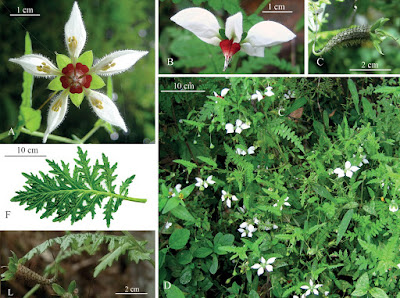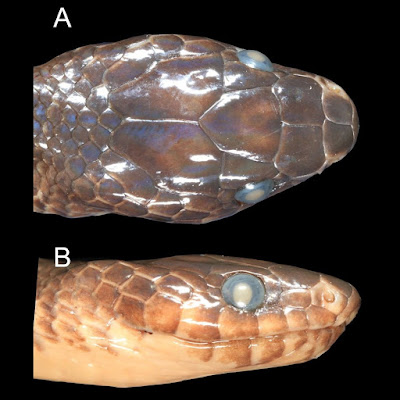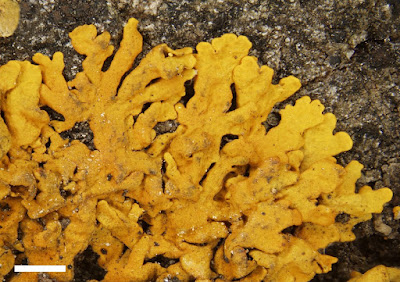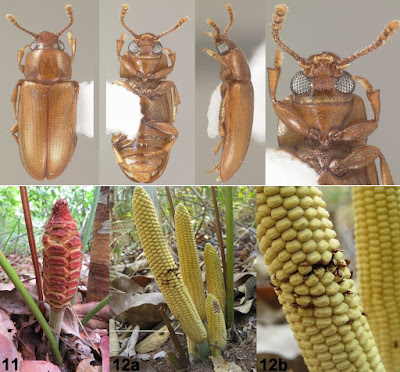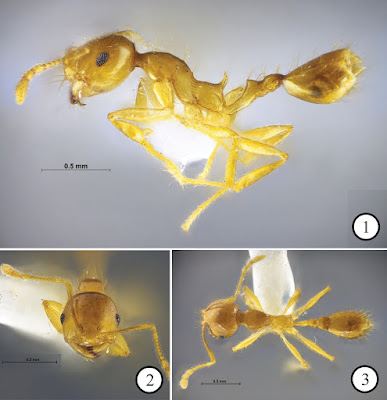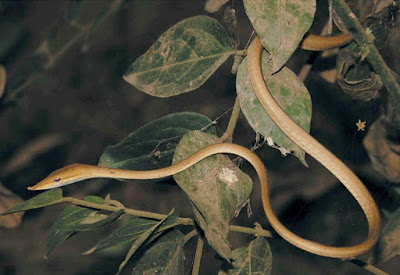[Most Recent Entries] [Calendar View]
Monday, April 29th, 2019
| Time | Event | ||||
| 1:17a | [Botany • 2019] Nasa angeldiazioides (Loasaceae) • A New Striking and Critically Endangered Species of Nasa from North Peru
Abstract Nasa angeldiazioides sp. nov. is described and illustrated. The species is restricted to two forest remnants on the western slope of the northern Peruvian Andes (Dept. Lambayeque) where it is found in the undergrowth of primary forest. The new taxon shows a unique leaf morphology in the family Loasaceae. Molecular and morphological data show that the new species belongs to the Nasa triphylla group. Since the relic forests of the north-western Andes are increasingly threatened by the effects of climate change, i.e. droughts and wildfires, the new species already faces imminent extinction. Keywords: Loasaceae, Peru, Laquipampa, Nasa, Lambayeque, Amotape-Huancabamba-Zone, narrow-endemic, Chiñama, Angeldiazia, new species Nasa angeldiazioides T.Henning, R.H.Acuña, E.Rodr., L.García-Llatas & Weigend, sp. nov. Diagnosis: Nasa angeldiazioides is similar to N. bicornuta, N. pteridophylla and N. urens but differs in having strongly amplexicaul leaves, sessile to amplexicaul prophylls on the pedicels and flowers with white petals and dark red nectar scales. The unique interrupted bipinnatisect leaves with rounded leaflet apices distinguish N. angeldiazioides from all other taxa of Nasa and Loasaceae as a whole. Etymology: The epithet refers to a recently described monotypic genus of Asteraceae from the same area, Angeldiazia weigendii M.O.Dillon & Zapata (Dillon and Zapata 2010). The latter species has an extremely peculiar leaf morphology: deeply pinnatisect, amplexicaulous leaves with rounded leaflet apices, i.e. leaves that in the living state look extremely similar to the upper leaves and bracts of the new species here described (Figs 2J–M, 3A). Tilo Henning, Rafael Acuña Castillo, Eric Frank Rodríguez Rodríguez, Luis Felipe García Llatas and Maximilian Weigend. 2019. A New Striking and Critically Endangered Species of Nasa (Loasaceae, Cornales) from North Peru. PhytoKeys. 121: 13-28. DOI: 10.3897/phytokeys.121.33927 Resumen: Se describe e ilustra la especie inédita Nasa angeldiazioides sp. nov. Esta especie está restringida a dos remanentes de bosque de la vertiente occidental de los Andes del norte del Perú (Depto. Lambayeque), donde se la encuentra en el sotobosque de bosques primarios. Nasa angeldiazioides muestra una morfología foliar única en la familia Loasaceae. Tanto la evidencia morfológica como la molecular muestran que esta nueva especie pertenece al grupo de Nasa triphylla. Dado que los bosques relictos de los Andes noroccidentales del Perú se encuentran cada vez más amenazados por los efectos del cambio climático, como lo son las sequías e incendios forestales más frecuentes, esta nueva especie podría estar enfrentando una extinción inminente. | ||||
| 2:04a | [Botany • 2019] Argyreia decemloba (Convolvulaceae) • A New Species of Argyreia from Chin State, Myanmar
Abstract Argyreia decemloba Traiperm, Fujikawa & Staples, a new species of Convolvulaceae from Natma Taung National Park, Chin State, Myanmar, is described here with detailed illustrations and summaries for its distribution, ecology and IUCN conservation status. This new species is a high-climbing twiner that can be distinguished by a white or pale yellow corolla with a deep red or purple-black colour inside at the base of the tube, a ten-lobed corolla limb, and staminal filament bases expanded and densely covered by hispid hairs. Argyreia decemloba is here assessed as Near Threatened (NT) following IUCN Red List categories. KEYWORDS: Argyreia, Chin State, Convolvulaceae, filament morphology, Mount Victoria, Myanmar, Natma Taung, new species discovery, SE Asian biodiversity, staminal trichomes, taxonomy Argyreia decemloba Traiperm, Fujikawa & Staples, sp. nov. Holotype: Myanmar, Chin State, Mindat Township, ... Diagnosis — Three species of Argyreia are known to have a white or pale yellow corolla with a deep red or purple-black colour inside at the base of the tube as well as a 10-lobed limb: A. barbata (Wall.) Raizada; A. maymyensis (Lace) Raizada; and A. decemloba (Table 1). Argyreia barbata and A. maymyensis have quite narrow, linear inflorescence- and floral bracts that do not cover up the calyx and corolla base; the hispid-hirsute indumentum of A. barbata, composed of dense, bristly hairs may obscure the floral organs underneath. In contrast, A. decemloba has broad, laminar inflorescence- and floral bracts that cover the floral organs underneath; the abaxial surface of the bracts has a completely different, dimorphic indumentum composed of two different trichome types (Table 1). .... Distribution and ecology — So far known only from Chin State, Myanmar, occurring at elevations of (740–)1025–1200(–1530) m. A high-climbing twiner in trees and shrubs inhabiting open, sunny places such as roadsides, footpaths in secondary forest, edges of deciduous forest, clearings in evergreen forest, and in semi-evergreen forest; preferring moist soils along streams or the banks of rivers. The soil type has not been reported. Etymology — The specific epithet recognizes the distinctive 10-lobed corolla limb. Paweena Traiperm, Kazumi Fujikawa, Natthaphong Chitchak, Prachaya Srisanga, Charun Maknoi and George Staples. 2019. A New Species of Argyreia (Convolvulaceae) from Myanmar. Willdenowia. 49(1); 65–70. DOI: 10.3372/wi.49.49108 | ||||
| 4:18a | [Herpetology • 2019] Stegonotus ayamaru • A New Species of Indo-Papuan Groundsnake, Genus Stegonotus Duméril et al., 1854 (Serpentes, Colubridae), from the Bird’s Head Peninsula of West Papua, Indonesia, with Comments on Differentiating Morphological Ch
Abstract We describe a new species of Indo-Papuan groundsnake (Stegonotus) from a single adult male specimen collected in 1953 near Kamro, a village in Maybrat Regency, West Papua, Indonesia. The specimen had been considered a member of S. batjanensis, a well-defined species from the northern Maluku Islands over 500 km to the northwest with which it shares the key characteristic of having the 3rd, 4th, and 5th supralabial scales touching the eyes. The new species can be differentiated from S. batjanensis as well as all other species of Stegonotus by having its 5th supralabial scale projecting forward from behind the eye to form a narrow contact zone with the eye. In addition, it is differentiated by the combination of the following characteristics: seven supralabials, the 3rd–5th touching the eye; eight infralabials, the 1st–4th touching the anterior genial; four scales separating the posterior genial and the first gastrostege; dorsal scales in 17 rows, diminishing to 15 posteriorly; a low number of ventrals (181 in the holotype) combined with a high number of subcaudals (105 in the holotype), the latter comprising 37% of the scales on the ventral surface, the highest proportion in the genus. The description of this species is of interest beyond adding to the species diversity of Stegonotus: it allowed us to explore additional characteristics to resolve taxonomic questions in a morphologically conservative genus, it illustrates the need for additional herpetological survey work on the Bird’s Head Peninsula, and its initial misidentification serves as a reminder of the continued relevance and importance of natural history collections as repositories for specimens and data that influence our knowledge today by reaching out from the past. Keywords: groundsnake, Stegonotus, new species, Bird’s Head Peninsula, West Papua, Indonesia, New Guinea, Reptilia
Stegonotus ayamaru sp. nov. Ayamaru Groundsnake Etymology. The species name ayamaru is a noun in apposition. It references the Ayamaru people of Maybrat Regency, West Papua, Indonesian New Guinea and their homonymic language. We select this name not only to indicate the type locality but also to highlight the Ayamaru people’s struggle to protect their forests and waterways from exploitation. The Ayamaru Lakes are a case in point. One of the several endemic fishes in the lake (Melanotaenia boesemani) has been over-collected and is currently listed as Endangered on the IUCN Red List (Allen 1996). West Papua was recently declared a conservation province (Anonymous 2018), and it is hoped that this will have a long-term, positive effect on regional development. Christine M. Kaiser, Mark O'Shea and Hinrich Kaiser. 2019. A New Species of Indo-Papuan Groundsnake, Genus Stegonotus Duméril et al., 1854 (Serpentes, Colubridae), from the Bird’s Head Peninsula of West Papua, Indonesia, with Comments on Differentiating Morphological Characters. Zootaxa. 4590(2); 201–230. DOI: 10.11646/zootaxa.4590.2.1 | ||||
| 4:32a | [Herpetology • 2019] Psammophylax ocellatus & P. ansorgii • Rediscovery, Taxonomic Status, and Phylogenetic Relationships of Two Rare and Endemic Snakes (Lamprophiidae: Psammophiinae) from the southwestern Angolan Plateau
Abstract Two rare and endemic psammophines (Serpentes: Psammophiinae) occur in Angola. The taxonomic status of Psammophylax rhombeatus ocellatus Bocage, 1873 and Psammophis ansorgii Boulenger, 1905 have long remained problematic, with both having varied past and present taxonomic assignments, and whose distributions may therefore present zoogeographic anomalies. Little was known of their biology, habitat associations, or phylogenetic relationships. New material was collected during biodiversity surveys of the Humpata Plateau, near Lubango, Angola. It allowed fuller descriptions of scalation and live coloration for both species, and resolution of their taxonomic status. Genetic analysis confirms that both are distinct at the specific level. In addition, within Psammophis, Jalla’s Sand Snake (Psammophis jallae Peracca, 1896), of which P. rohani Angel, 1925, remains a synonym, is sister to P. ansorgii, and Boulenger’s comment on similarities with P. crucifer are not supported. The status of an unusual skaapsteker from Calueque, Cunene Province, Angola, is discussed and its assignment to Ps. ocellatus is provisional and requires additional material for taxonomic resolution. The new P. ansorgii records from Tundavala represent a range (+400 km southwest) and altitude (1800 m to 2286 m a.s.l) extension from the previous only known precise locality of Bela Vista (= Catchiungo), Huambo Province, whilst that for Ps. ocellatus doubles the known altitude from 1108 m to 2286 m a.s.l and extends the range about 122 km to the northwest from historical material from the plateau of Huíla and Cunene provinces. Keywords: Psammophis ansorgii, Psammophylax ocellatus, new distribution, phylogenetic relationships, Angolan escarpment, montane grassland, Reptilia William R. Branch, Ninda Baptista, Chad Keates and Shelley Edwards. 2019. Rediscovery, Taxonomic Status, and Phylogenetic Relationships of Two Rare and Endemic Snakes (Serpentes: Psammophiinae) from the southwestern Angolan Plateau. Zootaxa. 4590(3); 342–366. DOI: 10.11646/zootaxa.4590.3.2 | ||||
| 6:39a | [Fungi • 2019] The Lichen Family Teloschistaceae in the Altai-Sayan Region (Central Asia)
Abstract Within the Altai-Sayan region, we identified 103 species of Teloschistaceae from 1193 field records supported by herbarium vouchers. The recorded species belong to the subfamilies Xanthorioideae (46 species in 14 genera) and Caloplacoideae (57 species in 17 genera); Teloschistoideae is absent. We divided the 194 surveyed localities into four categories: arid alpine, arid non-alpine, humid alpine, humid non-alpine. Each category has a specific lichen composition and a typical combination of traits. Humid non-alpine localities are mostly inhabited by broadly distributed boreal-montane species; humid alpine sites by arctic-alpine lichens; arid non-alpine habitats are preferred by xerophilous Eurasian species and arid alpine sites by xerophilous Central Asian species with (presumably) large geographic ranges in dry continental Asia. Some arid alpine species have a thick crustose thallus with a very thick medulla and cortex; this morphological trait is confined to the Central Asian group of lichens and is absent from other climatic regions, such as arctic, boreal or oceanic Eurasia. We compared species diversity in the Altai-Sayan region with the Alps. Both regions differ in species and generic composition and the richness is higher in the latter. Taxonomy: Caloplaca fluviatilis is newly described. New combinations are Pachypeltis insularis, P. pachythallina, P. phoenicopta and Variospora sororicida. Two of Magnusson’s names are newly synonymized: Caloplaca infestans with Pachypeltis intrudens and Caloplaca kansuensis with C. bicolor. In addition to 22 known genera, we define, provisionally, 9 groups of species that may merit recognition as genera. Caloplaca epithallina is provisionally placed in Shackletonia, but we do not formally publish a new combination. Lichenicolous Pachypeltis phoenicopta and Variospora sororicida are less host-specific than originally thought. Floristics: Caloplaca pratensis is new to Eurasia, Caloplaca helygeoides (= C. diphyodes auct.), C. monacensis and C. soralifera are new to Asia. 12 species are new to Russia, 9 new to Siberia, 9 new to China, 2 new to Kazakhstan, and 2 new to Xinjiang. Outside the studied region Pachypeltis phoenicopta is new to Europe (Spain, Sierra Nevada) and we report the first reliable record of Pachypeltis insularis from Greece (Mt Olympus).
Jan Vondrák, Ivan Frolov, Evgeny A. Davydov, Lidia Yakovchenko, Jiří Malíček , Stanislav Svoboda and Jiří Kubásek. 2019. The Lichen Family Teloschistaceae in the Altai-Sayan Region (Central Asia). Phytotaxa. 396(1); 1–66. DOI: 10.11646/phytotaxa.396.1 | ||||
| 9:09a | [Entomology • 2019] Pharaxonotha cerradensis • A New Species of Pharaxonotha Reitter (Coleoptera: Erotylidae) from central South America
Abstract Pharaxonotha cerradensis, new species (Coleoptera: Erotylidae), is described from Bolivia and Brazil. It belongs in a complex of species from Mexico and Central America that radiated on host cycads of the genus Zamia L. (Cycadales: Zamiaceae) and is associated with Zamia boliviana (Brongniart) A. DC. (Cycadales: Zamiaceae). Pharaxonotha cerradensis is compared with other species of Pharaxonotha Reitter. Keywords: Neotropical, Cerrado, Cucujoidea, Pharaxonothinae, host plants, Coleoptera
Pharaxonotha cerradensis Skelley and Segalla, new species Diagnosis. Pharaxonotha cerradensis can be distinguished from other members of the genus by the pronotal anterior angles being rounded, antennomeres VII and VIII each with width = length, pronotal and elytral setae short and not reaching next puncture, protibia narrowly triangular with a distinct apical lateral tooth, and pronotal disc with distinct sulcus at base on each side. Pharaxonotha cerradensis is readily distinguished from all other species of Pharaxonotha by its enlarged antennomere XI, 1.6× longer than antennomere X. In addition, this is the only member of the genus known to occur in central South America on the host cycad Zamia boliviana. Etymology. The host cycad of this beetle occurs in the biome known as the Cerrado in Brazil and Savanna in Bolivia. The species epithet cerrad-ensis means “of the Cerrado”. Paul E. Skelley and Rosane Segalla. 2019. A New Species of Pharaxonotha Reitter (Coleoptera: Erotylidae) from central South America. Zootaxa. 4590(1); 184–190. DOI: 10.11646/zootaxa.4590.1.9 | ||||
| 9:11a | [Entomology • 2019] Recurvidris lekakuli • A New Species of the Ant Genus Recurvidris Bolton, 1992 (Hymenoptera, Formicidae, Myrmicinae) from Thailand
Abstract Recurvidris Bolton, 1992 is a small myrmicine genus of the tribe Crematogastrini. Until now, eleven species are known in this genus from Asia. A new species, Recurvidris lekakuli sp. n., is here described from Thailand based on the worker caste. The type series of the new species was collected from leaf litter in a dry evergreen forest. A key to the Asian species of Recurvidris based on the worker caste is provided. Keywords: Formicidae, ants, Recurvidris, new species, taxonomy, Thailand Recurvidris lekakuli sp. n. Diagnosis: Head in full-face view round, almost as long as broad; masticatory margin of mandible with four sharp teeth, fourth (basal) tooth almost as large as third tooth; basal margin with a small tooth; propodeal declivity lacking infradental lamella or ridge linking propodeal spine to metapleural lobe; head, promesonotum, propodeum, petiolar node, postpetiole and gaster entirely smooth and shiny; mesopleuron and peduncle of petiole superficially reticulate with slightly smooth and shiny interspaces; propodeal dorsum with a pair of very short appressed hairs in front of spiracles.
Etymology: The specific name is dedicated to the late Dr. Boonsong Lekakul, who was the most excellent specialist in zoological sciences in Thailand and helped and inspired many young biologists. Bionomics: The type series was collected from leaf litter on the forest floor in a dry evergreen forest (Figure 6) near a stream. Distribution: Recurvidris lekakuli has been known only from the type locality. The most closely related species, R. chanapaithooni was recorded from eastern and southern Thailand (Jaitrong and Wiwatwitaya 2015). This species is very probably sympatric with R. lekakuli in at least the dry evergreen forest in western and/or southern Thailand. Weeyawat Jaitrong, Yuppayao Tokeeree and Piyaporn Pitaktunsakul. 2019. A New Species of the Ant Genus Recurvidris Bolton, 1992 (Hymenoptera, Formicidae, Myrmicinae) from Thailand. ZooKeys. 830: 53-61. DOI: 10.3897/zookeys.830.31147 | ||||
| 11:26a | [Herpetology • 2019] Ahaetulla laudankia • A New Species of Ahaetulla Link, 1807 (Colubridae: Ahaetullinae) from India
ABSTRACT A new species of vine snake of the genus Ahaetulla is described from peninsular India. The new taxon is a medium-sized arboreal snake, readily distinguished from all other congeners by morphological and genetic differences. The new species appears to be widely distributed in Eastern Ghats and Central India with the western-most distribution extending into eastern Rajasthan. However, it is relatively rare, with only three specimens being acquired over the past nine years. KEYWORDS: Ahaetulla nasuta, Eastern Ghats, Rajasthan, snake, taxonomy
Ahaetulla laudankia sp. nov. Dryophis mycterizans – Sclater (1891) [in part] Ahaetulla nasuta isabellinus – Dutta et al. (2009) Etymology. The specific epithet, laudankia, refers to the vernacular name of the species in Odia (language spoken in Odisha state of India), alluding to the snake’s resemblance to dried stems (‘danka’) of bottle gourd (‘lau’). Proposed standard English name: Laudankia Vine Snake V. Deepak, Surya Narayanan, Vivek Sarkar, Sushil K. Dutta and Pratyush P. Mohapatra. 2019. A New Species of Ahaetulla Link, 1807 (Serpentes: Colubridae: Ahaetullinae) from India. Journal of Natural History. 53(9-10); 497-516. DOI: 10.1080/00222933.2019.1589591 |
| << Previous Day |
2019/04/29 [Calendar] |
Next Day >> |


